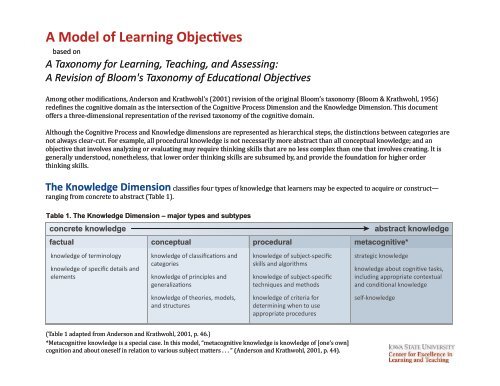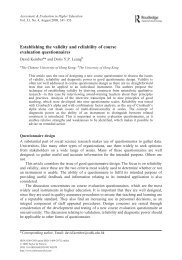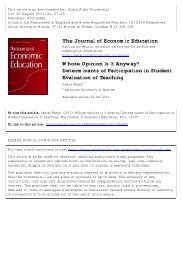A Model of Learning Objectives - Center for Excellence in Learning ...
A Model of Learning Objectives - Center for Excellence in Learning ...
A Model of Learning Objectives - Center for Excellence in Learning ...
Create successful ePaper yourself
Turn your PDF publications into a flip-book with our unique Google optimized e-Paper software.
A <strong>Model</strong> <strong>of</strong> <strong>Learn<strong>in</strong>g</strong> <strong>Objectives</strong><br />
based on<br />
A Taxonomy <strong>for</strong> <strong>Learn<strong>in</strong>g</strong>, Teach<strong>in</strong>g, and Assess<strong>in</strong>g:<br />
A Revision <strong>of</strong> Bloom's Taxonomy <strong>of</strong> Educational <strong>Objectives</strong><br />
Among other modiications, Anderson and Krathwohl’s (2001) revision <strong>of</strong> the orig<strong>in</strong>al Bloom’s taxonomy (Bloom & Krathwohl, 1956)<br />
rede<strong>in</strong>es the cognitive doma<strong>in</strong> as the <strong>in</strong>tersection <strong>of</strong> the Cognitive Process Dimension and the Knowledge Dimension. This document<br />
<strong>of</strong>fers a three-dimensional representation <strong>of</strong> the revised taxonomy <strong>of</strong> the cognitive doma<strong>in</strong>.<br />
Although the Cognitive Process and Knowledge dimensions are represented as hierarchical steps, the dist<strong>in</strong>ctions between categories are<br />
not always clear-cut. For example, all procedural knowledge is not necessarily more abstract than all conceptual knowledge; and an<br />
objective that <strong>in</strong>volves analyz<strong>in</strong>g or evaluat<strong>in</strong>g may require th<strong>in</strong>k<strong>in</strong>g skills that are no less complex than one that <strong>in</strong>volves creat<strong>in</strong>g. It is<br />
generally understood, nonetheless, that lower order th<strong>in</strong>k<strong>in</strong>g skills are subsumed by, and provide the foundation <strong>for</strong> higher order<br />
th<strong>in</strong>k<strong>in</strong>g skills.<br />
The Knowledge Dimension classiies four types <strong>of</strong> knowledge that learners may be expected to acquire or construct—<br />
rang<strong>in</strong>g from concrete to abstract (Table 1).<br />
Table 1. The Knowledge Dimension – major types and subtypes<br />
concrete knowledge<br />
factual conceptual procedural metacognitive*<br />
abstract knowledge<br />
knowledge <strong>of</strong> term<strong>in</strong>ology<br />
knowledge <strong>of</strong> specific details and<br />
elements<br />
knowledge <strong>of</strong> classifications and<br />
categories<br />
knowledge <strong>of</strong> pr<strong>in</strong>ciples and<br />
generalizations<br />
knowledge <strong>of</strong> subject-specific<br />
skills and algorithms<br />
knowledge <strong>of</strong> subject-specific<br />
techniques and methods<br />
strategic knowledge<br />
knowledge about cognitive tasks,<br />
<strong>in</strong>clud<strong>in</strong>g appropriate contextual<br />
and conditional knowledge<br />
knowledge <strong>of</strong> theories, models,<br />
and structures<br />
knowledge <strong>of</strong> criteria <strong>for</strong><br />
determ<strong>in</strong><strong>in</strong>g when to use<br />
appropriate procedures<br />
self-knowledge<br />
(Table 1 adapted from Anderson and Krathwohl, 2001, p. 46.)<br />
*Metacognitive knowledge is a special case. In this model, “metacognitive knowledge is knowledge <strong>of</strong> [one’s own]<br />
cognition and about oneself <strong>in</strong> relation to various subject matters . . . ” (Anderson and Krathwohl, 2001, p. 44).
This taxonomy provides a framework <strong>for</strong> determ<strong>in</strong><strong>in</strong>g and clarify<strong>in</strong>g learn<strong>in</strong>g objectives.<br />
<strong>Learn<strong>in</strong>g</strong> activities <strong>of</strong>ten <strong>in</strong>volve both lower order and higher order th<strong>in</strong>k<strong>in</strong>g skills as well as a mix <strong>of</strong> concrete and abstract knowledge.<br />
The Cognitive Process Dimension represents a cont<strong>in</strong>uum <strong>of</strong> <strong>in</strong>creas<strong>in</strong>g cognitive complexity—from lower order<br />
th<strong>in</strong>k<strong>in</strong>g skills to higher order th<strong>in</strong>k<strong>in</strong>g skills. Anderson and Krathwohl (2001) identify n<strong>in</strong>eteen speciic cognitive processes that further<br />
clarify the scope <strong>of</strong> the six categories (Table 2).<br />
Table 2. The Cognitive Processes dimension — categories & cognitive processes and alternative names<br />
lower order th<strong>in</strong>k<strong>in</strong>g skills<br />
higher order th<strong>in</strong>k<strong>in</strong>g skills<br />
remember understand apply analyze evaluate create<br />
recogniz<strong>in</strong>g<br />
• identify<strong>in</strong>g<br />
recall<strong>in</strong>g<br />
• retriev<strong>in</strong>g<br />
<strong>in</strong>terpret<strong>in</strong>g<br />
• clarify<strong>in</strong>g<br />
• paraphras<strong>in</strong>g<br />
• represent<strong>in</strong>g<br />
• translat<strong>in</strong>g<br />
exemplify<strong>in</strong>g<br />
• illustrat<strong>in</strong>g<br />
• <strong>in</strong>stantiat<strong>in</strong>g<br />
classify<strong>in</strong>g<br />
• categoriz<strong>in</strong>g<br />
• subsum<strong>in</strong>g<br />
summariz<strong>in</strong>g<br />
• abstract<strong>in</strong>g<br />
• generaliz<strong>in</strong>g<br />
<strong>in</strong>ferr<strong>in</strong>g<br />
• conclud<strong>in</strong>g<br />
• extrapolat<strong>in</strong>g<br />
• <strong>in</strong>terpolat<strong>in</strong>g<br />
• predict<strong>in</strong>g<br />
compar<strong>in</strong>g<br />
• contrast<strong>in</strong>g<br />
• mapp<strong>in</strong>g<br />
• match<strong>in</strong>g<br />
expla<strong>in</strong><strong>in</strong>g<br />
• construct<strong>in</strong>g models<br />
execut<strong>in</strong>g<br />
• carry<strong>in</strong>g out<br />
implement<strong>in</strong>g<br />
• us<strong>in</strong>g<br />
differentiat<strong>in</strong>g<br />
• discrim<strong>in</strong>at<strong>in</strong>g<br />
• dist<strong>in</strong>guish<strong>in</strong>g<br />
• focus<strong>in</strong>g<br />
• select<strong>in</strong>g<br />
organiz<strong>in</strong>g<br />
• f<strong>in</strong>d<strong>in</strong>g coherence<br />
• <strong>in</strong>tegrat<strong>in</strong>g<br />
• outl<strong>in</strong><strong>in</strong>g<br />
• pars<strong>in</strong>g<br />
• structur<strong>in</strong>g<br />
attribut<strong>in</strong>g<br />
• deconstruct<strong>in</strong>g<br />
check<strong>in</strong>g<br />
• coord<strong>in</strong>at<strong>in</strong>g<br />
• detect<strong>in</strong>g<br />
• monitor<strong>in</strong>g<br />
• test<strong>in</strong>g<br />
critiqu<strong>in</strong>g<br />
• judg<strong>in</strong>g<br />
generat<strong>in</strong>g<br />
• hypothesiz<strong>in</strong>g<br />
plann<strong>in</strong>g<br />
• design<strong>in</strong>g<br />
produc<strong>in</strong>g<br />
• construct<strong>in</strong>g<br />
(Table 2 adapted from Anderson and Krathwohl, 2001, pp. 67–68.)
A statement <strong>of</strong> a learn<strong>in</strong>g objective conta<strong>in</strong>s a verb (an action) and an object (usually a noun).<br />
• The verb generally refers to [actions associated with] the <strong>in</strong>tended cognitive process.<br />
• The object generally describes the knowledge students are expected to acquire<br />
or construct. (Anderson and Krathwohl, 2001, pp. 4–5)<br />
In this model, each <strong>of</strong> the colored blocks shows an example <strong>of</strong> a<br />
learn<strong>in</strong>g objective that generally corresponds with each <strong>of</strong> the various<br />
comb<strong>in</strong>ations <strong>of</strong> the cognitive process and knowledge dimensions.<br />
Remember: these are learn<strong>in</strong>g objectives—not learn<strong>in</strong>g activities.<br />
It may be useful to th<strong>in</strong>k <strong>of</strong> preced<strong>in</strong>g each objective<br />
with someth<strong>in</strong>g like: “Students will be able to . . .”<br />
*Anderson, L.W. (Ed.), Krathwohl, D.R. (Ed.),<br />
Airasian, P.W., Cruikshank, K.A., Mayer, R.E.,<br />
P<strong>in</strong>trich, P.R., Raths, J., & Wittrock, M.C. (2001).<br />
A taxonomy <strong>for</strong> learn<strong>in</strong>g, teach<strong>in</strong>g, and<br />
assess<strong>in</strong>g: A revision <strong>of</strong> Bloom's Taxonomy <strong>of</strong><br />
Educational <strong>Objectives</strong> (Complete edition).<br />
New York: Longman.<br />
Identify<br />
strategies <strong>for</strong> reta<strong>in</strong><strong>in</strong>g<br />
<strong>in</strong><strong>for</strong>mation.<br />
Predict<br />
one’s response to<br />
culture shock.<br />
Recall<br />
how to per<strong>for</strong>m<br />
CPR.<br />
Use<br />
techniques that match<br />
one’s strengths.<br />
Clarify<br />
assembly<br />
<strong>in</strong>structions.<br />
Deconstruct<br />
one’s biases.<br />
Carry out<br />
pH tests <strong>of</strong> water<br />
samples.<br />
Classify<br />
adhesives by<br />
toxicity.<br />
Reflect<br />
on one’s<br />
progress.<br />
Integrate<br />
compliance with<br />
regulations.<br />
Provide<br />
advice to<br />
novices.<br />
Create<br />
an <strong>in</strong>novative learn<strong>in</strong>g<br />
portfolio.<br />
Judge<br />
efficiency <strong>of</strong> sampl<strong>in</strong>g<br />
techniques.<br />
Differentiate<br />
high and low<br />
culture.<br />
Respond<br />
to frequently asked<br />
questions.<br />
Design<br />
an efficient project<br />
workflow.<br />
Determ<strong>in</strong>e<br />
relevance <strong>of</strong><br />
results.<br />
Select<br />
the most complete list<br />
<strong>of</strong> activities.<br />
Assemble<br />
a team <strong>of</strong><br />
experts.<br />
Check<br />
<strong>for</strong> consistency among<br />
sources.<br />
Generate<br />
a log <strong>of</strong> daily<br />
activities.<br />
Recognize<br />
symptoms <strong>of</strong><br />
exhaustion.<br />
Summarize<br />
features <strong>of</strong> a new<br />
product.<br />
List<br />
primary and secondary<br />
colors.<br />
<strong>Model</strong> created by: Rex Heer<br />
Iowa State University<br />
<strong>Center</strong> <strong>for</strong> <strong>Excellence</strong> <strong>in</strong> <strong>Learn<strong>in</strong>g</strong> and Teach<strong>in</strong>g<br />
Updated January, 2012<br />
Licensed under a Creative Commons Attribution-<br />
NonCommercial-ShareAlike 3.0 Unported License.<br />
For additional resources, see:<br />
www.celt.iastate.edu/teach<strong>in</strong>g/RevisedBlooms1.html









